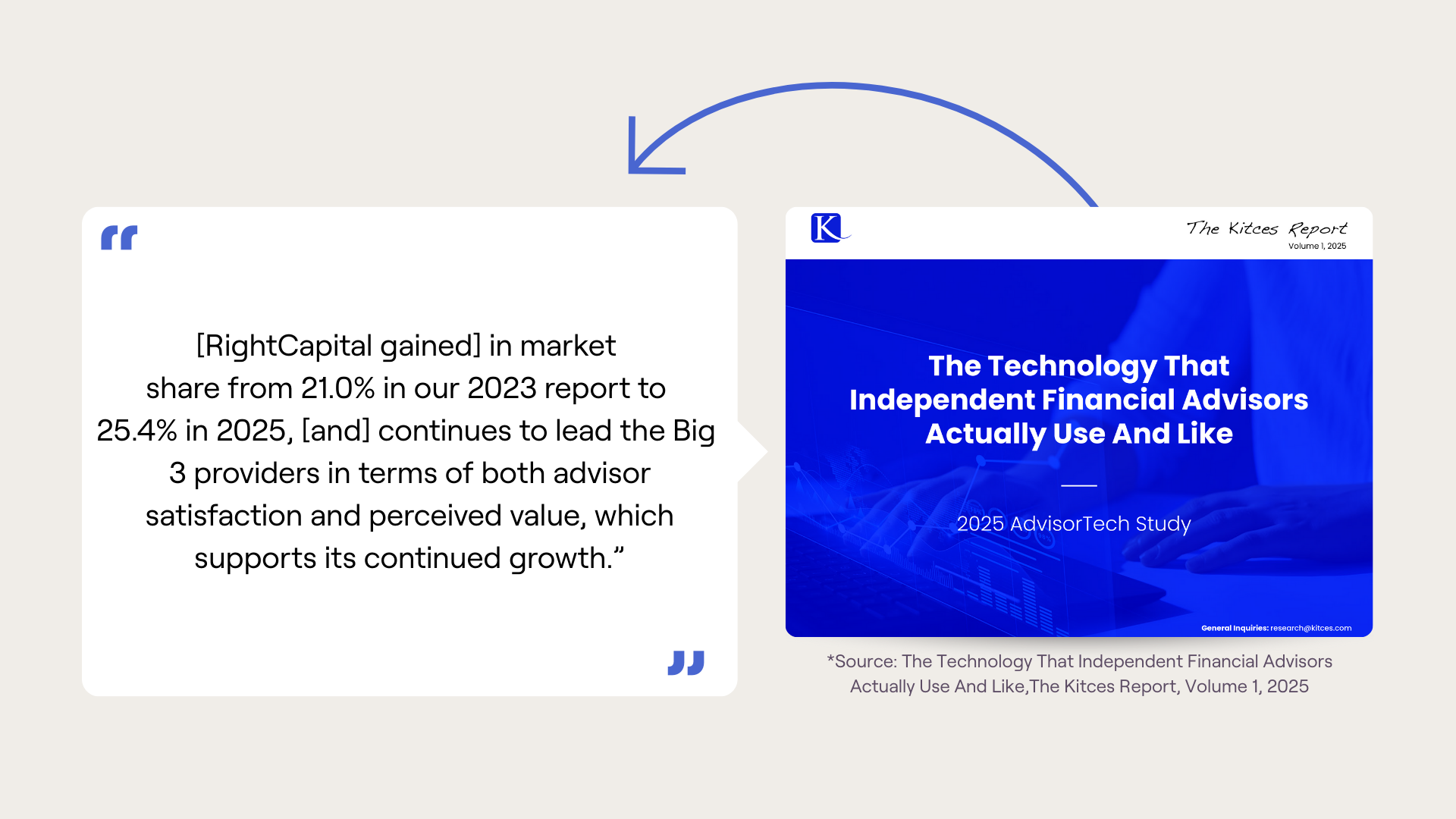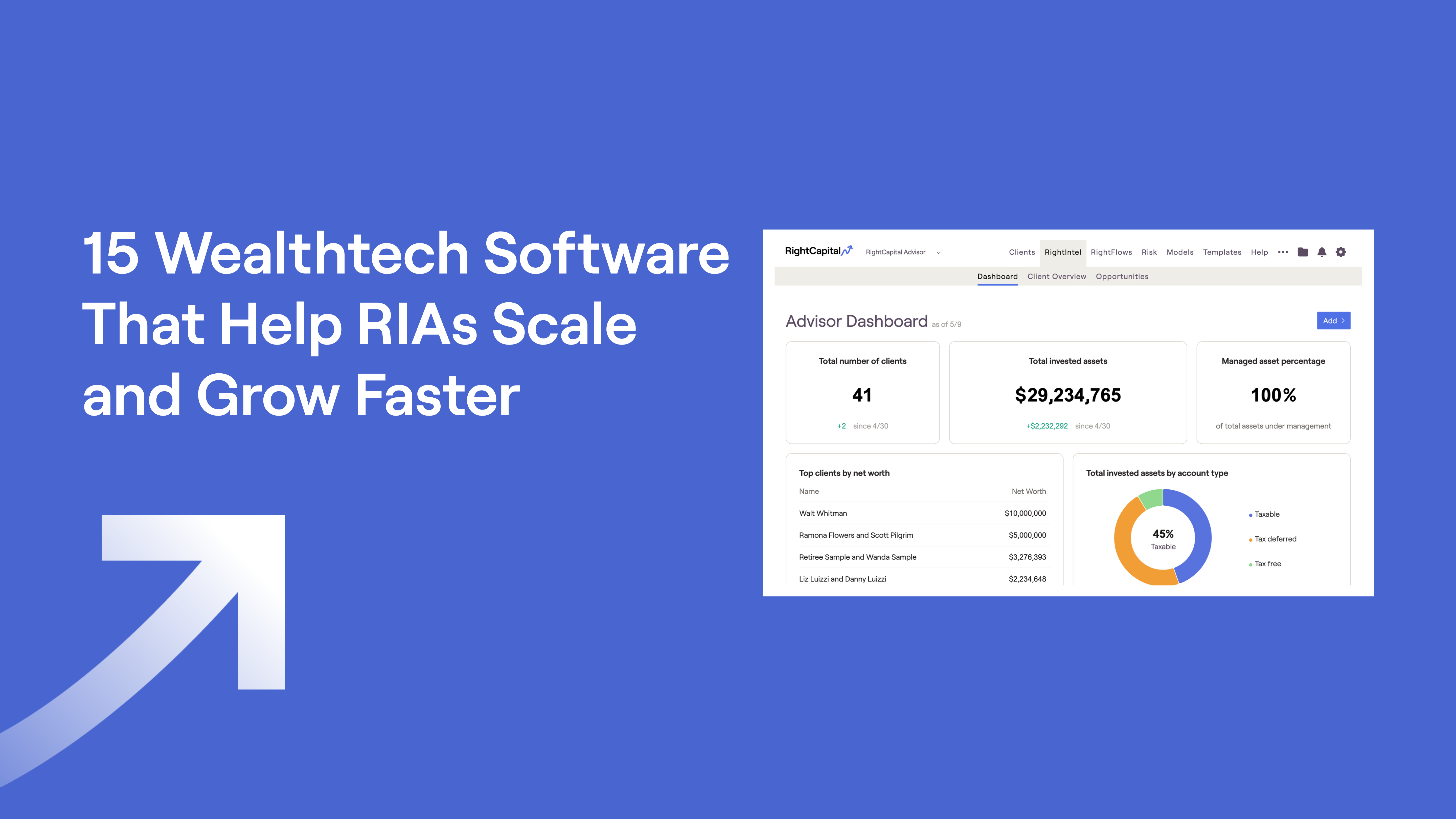OBBB Act Tax Law Changes: What Advisors Need to Know Now
August 26, 2025
The One Big, Beautiful Bill (OBBB) Act, which took effect July 4th, 2025, enacted several key tax law changes that will impact how advisors help clients navigate decisions around retirement planning, estate strategies, and charitable giving.
This guide covers what changed, why it matters, and how to model possible scenarios in RightCapital. It breaks down five priority provisions, provides a playbook for practical strategies that deliver results, and includes an example of how to apply these changes with clients.
The 5 biggest tax law changes to prioritize
Tax law change #1. SALT cap increases for 2025 to 2029
What changed
The state and local tax (SALT) deductibility cap increased from $5,000 to $20,000 for married couples filing separately, and from $10,000 to $40,000 for married couples filing jointly.
These changes are applicable for tax years 2025 through 2029. In 2030, the deductibility cap reverts back to $5,000 for married couples filing separately and $10,000 for married couples filing jointly.
The higher caps aren’t unlimited. If modified adjusted gross income (MAGI) rises above $500,000 for married couples filing jointly or $250,000 for married couples filing separately, the deduction is reduced by 30% of the excess. It cannot fall below the old $10,000/$5,000 levels.
Both the thresholds and the caps then climb by 1% each year.
Why it matters
Households in high-tax states may benefit from itemizing in certain years but still must clear the standard deduction hurdle. Side-by-side modeling helps clients see which path reduces their overall taxes in a given year.
What to do
Run the numbers annually. In some years, itemizing will come out ahead; in others, the standard deduction will be the best option.
Between 2025 and 2029, it may also pay to bunch SALT payments with other deductions. Keep an eye on MAGI thresholds so clients understand how the phase-outs affect what they actually receive.
Tax law change #2. New limitation on itemized deductions for higher earners starting in 2026
What changed
Beginning in 2026, a new tax law reduces itemized deductions by 2/37ths of the lesser of two amounts:
The total itemized deductions, or
The amount by which taxable income plus total itemized deductions exceeds the 37% tax bracket threshold.
The Pease limitation remains repealed. This bill creates an entirely new rule for reducing itemized deductions.
Why it matters
For clients in the highest tax bracket, the value of itemizing shrinks under the new reduction formula. Deductions like SALT and charitable gifts won’t go as far once the 2/37 rule applies.
What to do
Plan the timing of major deductions with care. Consider donor-advised funds where appropriate. Run projections to show how much the reduction lowers benefits each year beginning in 2026.
Tax law change #3. Standard deduction increases (2025), temporary senior deductions (2025–2028), and new charitable deductions for non-itemizers (from 2026)
What changed
For 2025, the standard deduction increased: Single filers go from $15,000 to $15,750, head of household from $22,500 to $23,625, and married couples filing jointly from $30,000 to $31,500.
There’s also a new $6,000 deduction for those 65 and older, available from 2025 through 2028.
There is a phaseout for households with modified adjusted gross income (MAGI) above $150,000 for married couples filing jointly, or $75,000 for all other filers. The deduction is reduced by 6% of income over those thresholds, with a full phase-out at $250,000 (married filing jointly) or $175,000 (all other filers).
A Social Security number is required on the return to qualify.
Starting in 2026, taxpayers can also claim a $1,000 per person charitable deduction on top of the standard deduction.
Why it matters
Beginning in 2026, even non-itemizers can claim a charitable deduction. Between 2025 and 2028, seniors may also meaningfully reduce taxable income, subject to the phase-out rules.
What to do
Coordinate the senior deduction window with qualified charitable distributions (QCDs), Roth conversions, and Social Security taxation strategies.
For non-itemizers in 2026 and beyond, plan for the $1,000 charitable deduction per filer and ensure they have all the proper documentation.
Tax law change #4. Qualified Business Income (QBI) deduction updates (from 2026)
What changed
The deduction remains up to 20% of qualified business income, plus 20% of qualified real estate investment trust (REIT) dividends and publicly traded partnership income. A minimum deduction of $400 applies, adjusted annually for inflation.
Beginning in 2026, the phase-out range expands to $75,000 for single filers and $150,000 for married couples filing jointly. Income earned through a C corporation or as an employee does not qualify. The deduction is available whether clients itemize or take the standard deduction.
Why it matters
The wider phase-out windows shift eligibility for many business owners and open new opportunities around compensation and timing of expenses.
What to do
Work with your business-owner clients to align compensation, entity structure, and expense timing with the phase-out ranges that start in 2026. Coordinate retirement plan contributions and charitable giving strategies as part of each client’s QBI planning.
Tax law change #5. Estate tax exemption increase (from 2026)
What changed
The estate tax exemption rises to $15 million starting in 2026 and will adjust annually for inflation. For context, the exemption was $5.49 million in 2017.
Why it matters
This increase raises thresholds for taxable estates and may shift gifting and transfer strategies.
What to do
Review how gifting, portability, and step-up opportunities fit into each client’s estate plan with the higher exemption in place.
Other key tax law changes starting in 2026
Alternative Minimum Tax (AMT) adjustments
Starting in 2026, the AMT phase-out thresholds revert to $500,000 for single filers and $1 million for married couples filing jointly, with amounts indexed to inflation.
The phase-out will increase by 50% of the amount that AMT income exceeds those thresholds. The AMT exemption itself stays the same.
What to do
Advisors should stress-test AMT exposure for higher-income clients, especially if they’re exercising incentive stock options (ISOs).
Tax Cuts and Jobs Act (TCJA) brackets made permanent
The TCJA income tax brackets will not sunset. Beginning in 2026 and beyond, today’s rates remain permanent: 10%, 12%, 22%, 24%, 32%, 35%, and 37%.
What to do
Advisors can continue using bracket-fill strategies, capital gains harvesting, and Roth conversion timing under the new permanent rates.
4 ways to keep clients ahead of the new tax law changes
Compare deductions before you file
Run annual side-by-side comparisons to decide between itemizing or taking the standard deduction. Use the 2025 to 2029 SALT window to bunch deductions into years when itemizing makes sense. And plan ahead for the new itemized deduction reduction that begins in 2026.
Stack charitable giving for retirees
For clients 70½ and older, qualified charitable distributions (QCDs) remain one of the most efficient giving tools, with a limit of $108,000 per person in 2025 under the “first dollar out” rule.
Beginning in 2026, non-itemizers can also claim a new $1,000 charitable deduction. Combining these strategies helps clients give generously while keeping taxable income in check.
Time Roth conversions with care
The larger standard deduction and temporary senior deduction window open a path for strategic conversions. But clients who cross IRMAA (Income Related Monthly Adjustment Amounts) thresholds could face higher Medicare premiums.
Careful timing protects them from surprises while building long-term tax-free income.
Optimize QBI for business owners
Expanded phase-out ranges starting in 2026 make it more important to coordinate wages, retirement plan contributions, and expense timing. Thoughtful planning helps more business owners stay eligible and maximize the deduction.
How to model these tax law changes in RightCapital
Build Baseline vs. OBBB planning scenarios
Create two plans side by side: one “status quo” baseline and one that layers in the OBBB changes. Show clients how taxes shift under each scenario, using examples like accelerating income before 2026 or delaying deductions into more favorable years. A clear before-and-after comparison helps make proactive planning tangible.
Toggle deductions to maximize savings
Run year-by-year comparisons between standard and itemized deductions. Pay attention to 2026, when itemized deduction limits return and SALT caps hit higher-tax states harder.
The temporary senior deduction (2025 to 2028) creates more room to stay with the standard deduction, while the $1,000 charitable deduction (starting in 2026) helps non-itemizers.
For charitably inclined clients, bunching deductions (stacking gifts or prepaid expenses in one year, then taking the standard deduction the next) makes the year-to-year switching between itemized and standard even more valuable.
Layer charitable giving with RMDs
Have clients use qualified charitable distributions (QCDs) to satisfy required minimum distributions. This helps keep MAGI down, reduces the share of Social Security subject to tax, and avoids IRMAA surcharges—all while supporting charitable goals.
Run Roth conversions with guardrails
Set annual Roth conversion targets using today’s bracket caps as a ceiling. Monitor IRMAA tiers to prevent unexpected Medicare premium hikes. Careful timing balances long-term tax-free growth with near-term cost control.
Stress-test business owner planning
Expanded phase-out ranges beginning in 2026 make it more important to model QBI inputs under different scenarios. Coordinate wages, retirement plan contributions, and expense timing, and revisit entity structure to see how today’s choices affect eligibility in later years.
Model estate outcomes under the new tax law
From 2026 onward, the exemption rises to $15 million. Model how that higher threshold changes estate tax exposure, portability between spouses, and lifetime gifting strategies.
Visualize the impact for clients
Use RightIntel charts to compare marginal and effective tax rates, standard vs. itemized outcomes, lifetime tax differences, and estate impacts. Before-and-after scenarios make the value of proactive planning tangible for clients.
A planning playbook you can reuse
Here’s a client profile you can model against OBBB’s new rules:
Married couple in their mid-60s, filing jointly
High property taxes
$1.5 to $2 million in tax-deferred accounts
Charitable intent
Run the scenarios step by step:
2025 through 2029: Compare itemizing vs. standard deduction; bunch SALT and charitable gifts when it helps
From 2026: Apply the new itemized deduction limitation; use the $1,000 non-itemized charitable deduction when taking the standard deduction
Clients 70½ and older: Turn on QCDs to meet RMDs tax-efficiently, following the “first dollar out” rule
Execute Roth conversions within target brackets, keeping IRMAA thresholds in view
Update estate assumptions for the $15 million exemption starting in 2026
When you put these strategies side by side, clients see the differences in lifetime taxes, IRMAA exposure, and after-tax wealth. The temporary senior deduction from 2025 to 2028 provides additional room for Roth conversions and other planning strategies.
Conclusion
The OBBB tax law changes aren’t abstract policy shifts. They create temporary openings and future constraints. From SALT and itemized limits to the senior and charitable deductions, QBI, AMT, and estate exemptions, the rules present short-term opportunities. But without proper planning, they may also yield longer-term costs.
The real value comes from showing clients the tradeoffs. Side-by-side scenarios make it clear how decisions affect lifetime taxes, Medicare premiums, and legacy outcomes. Turning those into simple, client-friendly visuals keeps the focus on what matters: protecting wealth and making smarter moves while the windows are open.
Disclaimer: This material is for educational purposes only. Advisors should recommend that clients consult their CPA or attorney for guidance on their specific tax and legal situations.
See how RightCapital helps you model the OBBB changes and turn them into strategies your clients can act on. Schedule a free demo.





